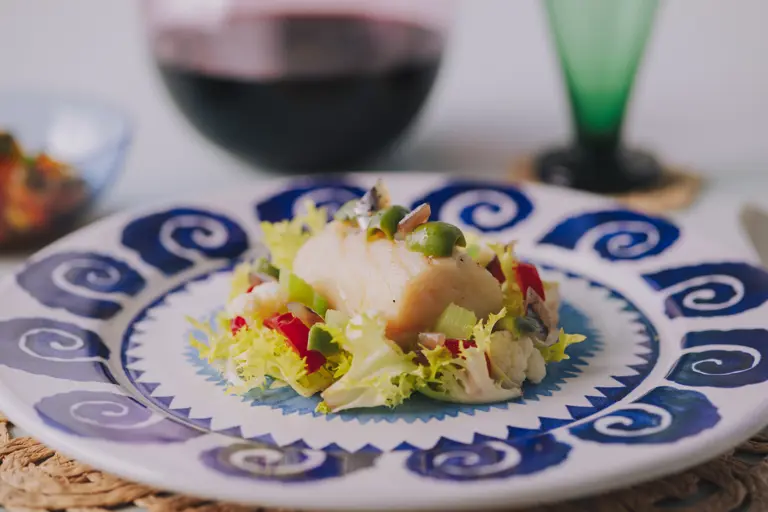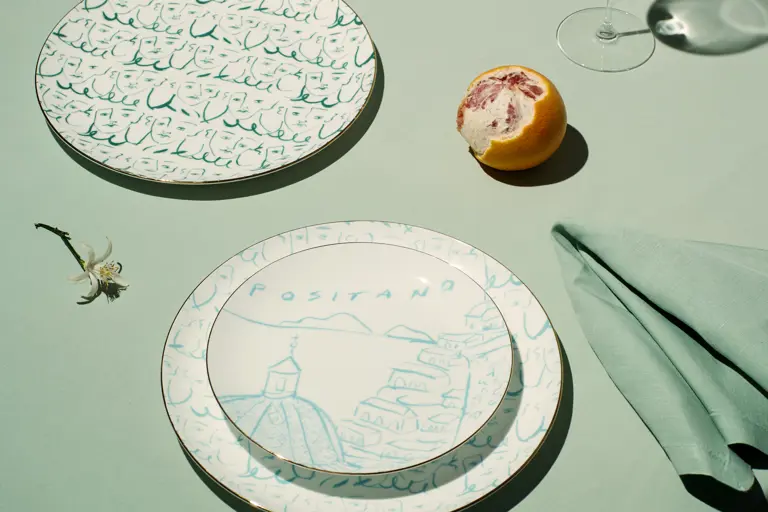FESTIVE ENTERTAINING, POSITANO STYLE
09.12.2021 EMPORIO SIRENUSE
Perhaps the commercialization of Christmas will eventually get the upper hand here too, but for now, at least in our experience, it’s the joy of being with friends and family in an atmosphere that is both convivial yet also somehow sacred that emerges most strongly, the delight with which children arrange figurines and furniture in the nativity crib, the sweet and savoury recipes associated with the season. Those of you who live Stateside will understand us when we say that in Italy – at least down here in the South – Christmas feels more like Thanksgiving.
Part of the pleasure of this time of year is the opportunity it provides to do things come si deve – as they are meant to be done. It’s an excuse to get out the best silver, the heirloom plates and glasses, to dress for dinner and open that bottle of wine that you’ve been keeping for just such an occasion.
Emporio Sirenuse has chosen early December to launch its new Home Collection in order to honour and celebrate this feeling of pride in beautiful things – those we choose to surround ourselves when entertaining special, much-loved guests.
The origins of the collection will be familiar to those who have followed Carla Sersale’s resortwear and lifestyle collection from its earliest days: a range of cushions featuring ancient Suzani motifs from Central Asia, embroidered in shimmering silk thread.
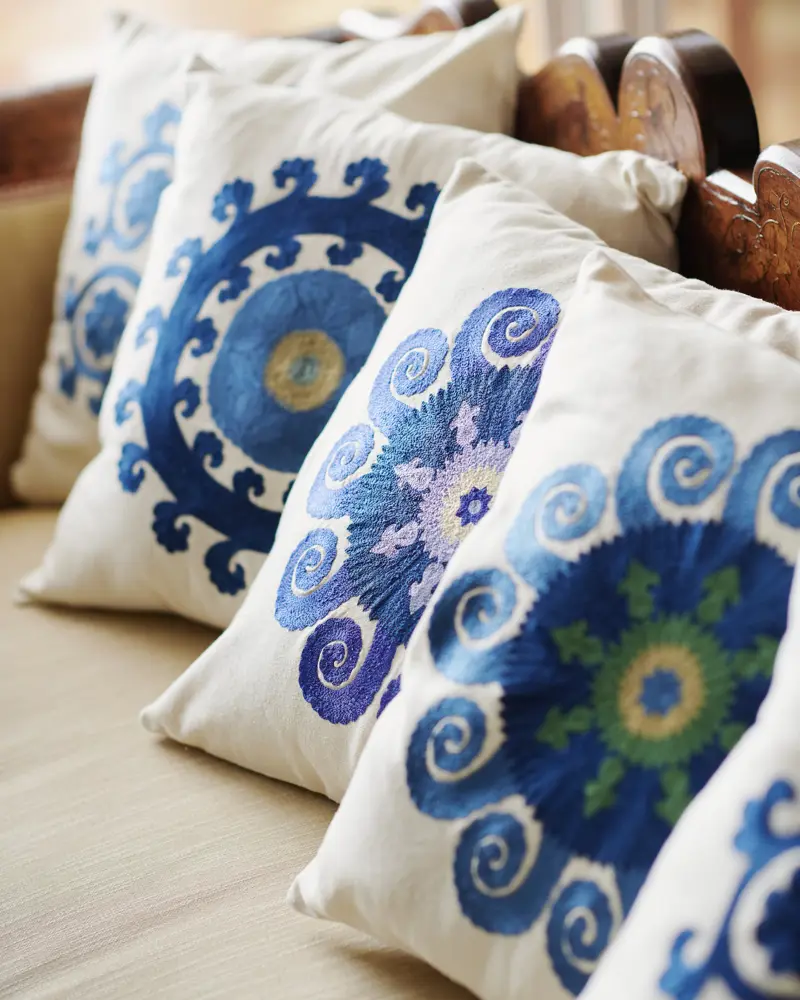
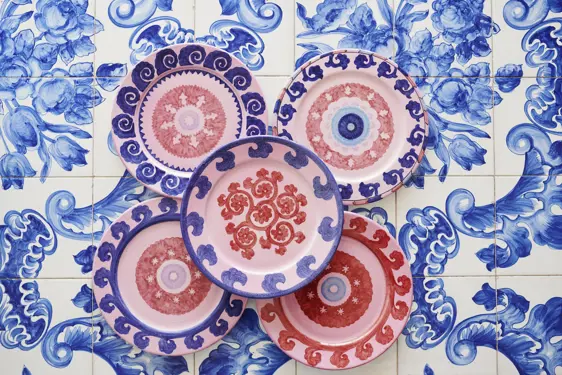
View
Now these mesmeric patterns of the nomadic steppes, adapted from patterns that appear in the wall hangings the late Franco Sersale loved to collect, have been reimagined in bold new colourways on a striking series of dinner plates and chargers crafted and hand-painted in the ceramics town of Vietri sul Mare.
The dinner plates feature a pattern of wistful, androgynous line-drawn faces, while the dessert plates and mugs bear Luke’s personal take on the iconic view of Positano’s pyramidical stack of houses, with the polychrome maiolica dome of the town’s parish church, Santa Maria Assunta, in the foreground
Perhaps the most exciting recent development in the world of Emporio Sirenuse homeware is the brand’s collaboration with artisanal glass firm Nason Moretti from the Venetian island of Murano. Designed exclusively for Emporio Sirenuse by Carla and creative director Viola Parrocchetti in collaboration with Piero Nason, the Aria range of glasses, bowls and pitchers brings the ethereal, shifting colours of the sunset view from the terrace of Le Sirenuse to your table. We have been using them for a few months now and love to select the hues of the glasses on the table to create moods, sometimes choosing a single tint like that tenuous, delicate turquoise, sometimes mixing them up in chromatic progressions that harmonise like musical chords.
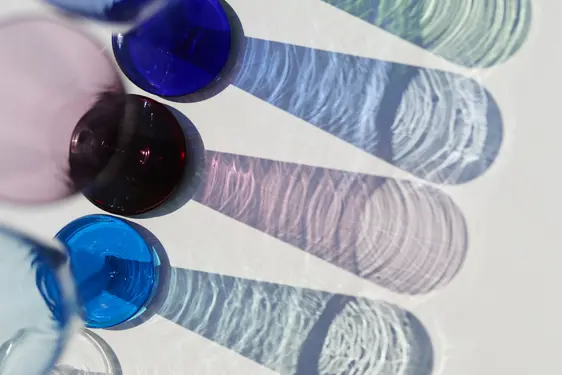
View
Emporio Sirenuse ships worldwide (with very few exceptions) and our homeware items make perfect presents. We guess you and the friends and family members you gift our tableware and glassware to need little prompting as to what to put on them, or in them.
But just in case, here’s a little gift from us to you: three seasonal recipes direct from the Amalfi Coast, two of them traditional Christmas dishes as prepared by Gennaro Russo, executive chef of Le Sirenuse’s La Sponda restaurant, the other a festive cocktail created by our head barman, Roberto Pane.
Happy Holidays from all of us at Positano!
Baccalà with escarole and cauliflower
Although abstinence from eating meat is now only an obligation on Ash Wednesday and Good Friday, it was long the rule for devout Catholics on Christmas Eve too. (And not only Christmas Eve… in the Middle Ages, meat was off-limits on as many as 150 days of the year). As a result, it’s traditional to serve fish on the cena della viglila – the Christmas Eve dinner which is the central Italian family festive season meal. Il giorno di natale or Christmas Day, in contrast, is not a big food day in Italy – many will go out to a restaurant for lunch or dinner with friends, or simply graze on leftovers.
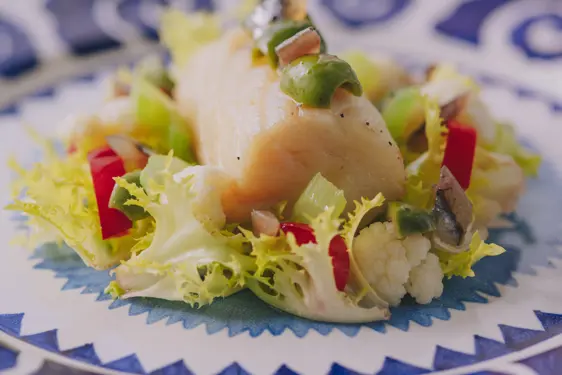
View
In Naples, as elsewhere in the peninsula, baccalà has long been the traditional centrepiece of the Christmas Eve meal. Baccalà is cod preserved in salt (as opposed to stoccafisso, which is air-dried cod). An important element of traditional Neapolitan cuisine – and a go-to protein on meatless days – salt cod needs to be soaked in water for at least 36 hours before it can be used, with frequent changes of water. Afterwards, strip the skin off the fillets (it should come off easily in one piece), then dry well. In La Sponda chef Gennaro Russo’s version of this classic dish, the baccalà is cooked confit-style, immersed in oil at a relatively low temperature. Paradoxically, this gives the fish a less oily texture than high-temperature deep-frying, though in both cases you should degrease after frying by laying the cod chunks on absorbent paper.
The papaccelle that feature in this recipe are small rounded red peppers, with a mild, sweet flavour, that are often served in southern and central Italy as aperitivo snacks, stuffed with mincemeat or tuna.
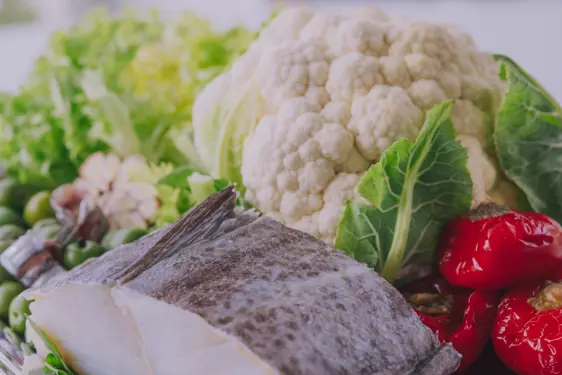
View
BACCALÀ WITH ESCAROLE AND CAULIFLOWER
Serves 4
- 600g soaked salt cod, cut into four fillets
- One small jar of anchovies preserved in olive oil
- 250g green olives
- One small jar of preserved red bell peppers or papaccelle
- 2 escaroles
- 1 medium cauliflower
- 4 cloves of garlic
- 5 sprigs of thyme
- Salt, vinegar and pepper to taste
- 2 litres extra-virgin olive oil
Choose a high-sided saucepan that can accommodate 4 salt cod fillets. Pour in the oil and heat it to around 75°C (150°F). Throw in the thyme sprigs, add some coarsely grated black pepper, and gently lower in the baccalà fillets. Regulate the heat so that the oil maintains a constant 75°C temperature and cook for 20 minutes.
Remove the outer leaves of the escarole and carefully detach and wash its tender inner leaves. Dry them with a cloth or piece of kitchen towel before serving. Drain the oil from the anchovies and cut them into small strips alongside the escarole, similarly prepared. Drain the olives and if necessary remove their stones.
Cut the cauliflower into bite-sized florets and toss them into a pan of boiling water (to which you have added a few drops of vinegar) for a few minutes until they’re cooked but still have some crunch to them.
Serve as a ring of escarole leaves with the cooked baccalà at its centre. Add the cauliflower, chopped anchovies and peppers, arranging the rest of the ingredients as the fancy takes you.
Struffoli di Natale
Sweet treats made from fried pastry are generally associated with Carnival in Italy – those days of indulgence and misrule prior to Lent that finish on martedì grasso (Mardi Gras or Shrove Tuesday). But these Neapolitan dough balls are an exception – they’re traditionally eaten around Christmas. They also exist in Calabria, where they’re called scalille, and Abruzzo, where they’re known as cicerchiata, due to their resemblance to the dried pulses known as cicerchie.

View
STRUFFOLI DI NATALE
Serves 8
- 400g (14 oz) fine plain white flour
- A pinch of salt
- 90g (3 fl oz) Strega liqueur
- 60g (2 oz) caster sugar
- 4 small whole eggs plus the yolk from 2 others
- 50g (1 ¾ oz) melted butter
- 10 g (2 teaspoons) orange zest
- 6 g (1 generous teaspoon) lemon zest
- 140g (5 oz) honey
- 10g (2 teaspoons) aniseed
- Confettini (nonpareils or sprinkles) and candied fruit to garnish
- 600ml (20 fl oz) peanut oil for frying
First a word on the main ingredient. Italians will always use what is known as “00” white flour in this kind of recipe. Italian mills grade flour by its fineness. 00 is the finest, generally used for unleavened items such as cakes, biscuits and other dolci, as well as shortcrust pastry in savoury pies and quiches, while the slightly coarser 0 is more often used for bread and pizza. Note that this system only rates the fineness of the flour, not its ‘strength’ or W number. But there is a connection: 00 flours are also usually ‘weak’ flours, meaning they contain less protein and need to absorb less water, which makes them better suited to a range of non-yeast recipes. Milling grade and W numbers are often difficult to ascertain on flours bought outside of Italy – but if you stick with plain white flour (and avoid self-raising) you should be fine.
Using a wooden spoon in a mixing bowl, or in the bowl of a food mixer on a low setting, combine the flour, sugar, salt and grated peel, then add the melted butter and the Strega liqueur. Knead to combine in the bowl and then on a floured surface until a homogenous ball has formed. Let this rest in the fridge for a couple of hours.
The aim is to create balls the size of small gnocchi or marbles. The best way to do this is to cut the dough into seven or eight slices and roll each slice into a long snake around 1cm thick. Cut this into 1cm pieces. Perfectionists will then make each struffoloball perfectly round by rolling it between the palms of the hand – this is your call.
Heat the peanut oil to 175°C (350°F). When it’s ready, add around 15-20 struffoli at a time, fry for 30-40 seconds, then remove with a slotted spoon, placing on greaseproof paper. Repeat until you’ve finished the whole batch.
Heat the honey to 120°C (250°F) in a wide saucepan and add the aniseed. Then throw in the struffoli and mix well to coat with honey. Arrange on a plate and garnish to taste with nonpareils (also known as sprinkles or hundreds and thousands) and candied fruit – lemon, orange, citron and cherry are those most often used in Naples.
Concerto Cocktail
Le Sirenuse’s head barman Roberto Pane created this Negroni variation to showcase Concerto, a liqueur that is as much a part of Amalfi Coast culture as limoncello – but far less well-known to outsiders. Its invention is commonly ascribed to the nuns of the former Conservatorio of Pucara, a remote hamlet that forms part of the scatter of mountain villages collectively known as Tramonti.
It’s classified as a rosolio – a type of home-made Italian liqueur based on a blend of alcohol, water and sugar, to which one or more flavouring ingredients are added. In the case of limoncello, there’s just the one additional ingredient, but Concerto can contain as many as fifteen different herbs and spices, plus barley and coffee – hence its name. It’s not a flavour sonata, it’s a flavour concerto.
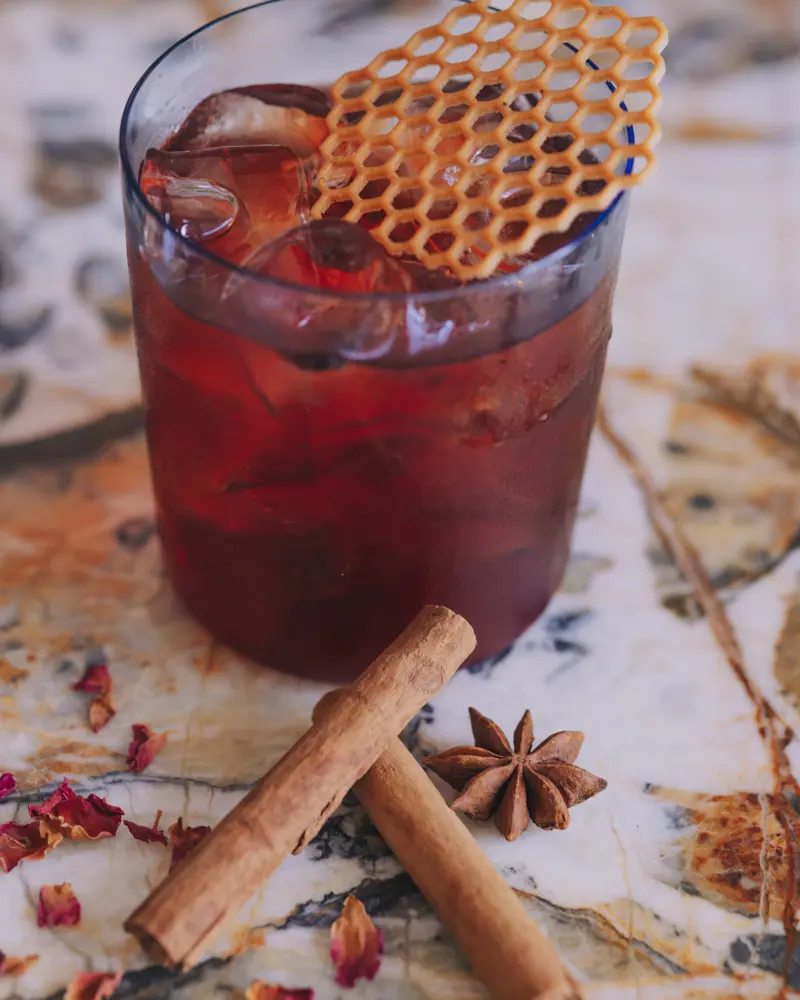
Traditionally, Concerto was used as a medicinal tonic for the nuns or the young damsels who they guarded and educated at the Conservatorio. But with its 30% proof rating, sugar-rush effect, heady herb and spice blend and coffee content, once it found its way into the community, this potent pick-me-up became both a way to get the party started when guests came to call and a DIY energy drink, one that helped sailors, shepherds and farmhands get out of bed and go on cold winter mornings.
Today, artisanal distilleries like Liquorificio Carlo Mansi continue to produce it, but so do many local families. Few, however, personally gather the herbs or assemble the exotic spices that go into Concerto as they can buy them ready-mixed from herbalists and pharmacies in Tramonti and Maiori. Even with this shortcut, distilling your own Concerto is a long process, one that families begin in the height of summer to be sure the liqueur is ready for winter drinking.
If you can’t track down Concerto where you live, you could try substituting it in with your favourite amaro. Better still, wait until you’re next in Positano, and ask Roberto to rustle one up for you.
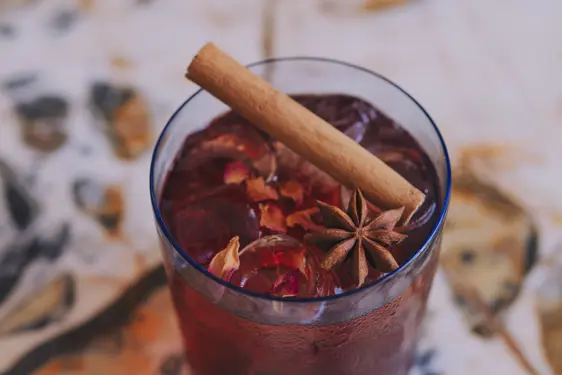
View
CONCERTO
- 50ml verbena-infused Campari
- 50ml London dry gin
- 12.5ml Concerto liqueur
- Cinammon sticks, star anise and dried rose petals to garnish
To make the verbena (or verveine) infused Campari, Roberto uses a roner (sous-vide machine), placing one litre of Campari and 30g of coarsely chopped verbena leaves in a sealed sous-vide bag and cooking it for two and a half hours at 55°C. A simpler but longer way of achieving the same effect is simply to put the leaves in a bowl with the Campari in a warm place and leave to infuse for a day or two. Whichever route you choose, strain the leaves out of the infusion before use.
At this point, the assembly is that of a classic Negroni: pour the three liquid ingredients onto ice cubes in a tumbler and stir. Garnish with a cinnamon stick, a star anise and some dried rose petals.
The new Emporio Sirenuse homeware collection is available now at www.emporiosirenuse.com
Photos © Roberto Salomone except Nason Moretti glassware, Suzani cushions and plates © Chiara Goia
Le Sirenuse Newsletter
Stay up to date
Sign up to our newsletter for regular updates on Amalfi Coast stories, events, recipes and glorious sunsets
